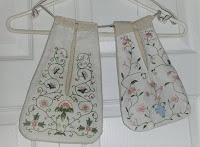How
many of us are getting fully dressed during the pandemic days? We have all seen the memes about “day
pajamas” and “night pajamas”.
In the 1850s, this was
not an option. Volunteers get many questions from our visitors about our
dresses, so let’s take a look at clothing that was worn.
Both
boys and girls wore dresses for the first few years. To tell the difference, a
girl’s dress was buttoned in the front and often had lace or pleats. At about
three years old, girls wore dresses similar to their mother, but with shorter
skirts and bloomers, and boys were dressed in knee pants. Once a child reached
twelve or thirteen, the boys began to wear long trousers and girls were dress
in full underpinnings, including their first corset.
Men were dress in collarless shirts, button-front
trousers, and a variety of coats. For upper and upper-middle class, their shirt
was a light colour. and trousers were snug fitting. For working men, the shirts
were often of a cotton print or gingham and the trousers were loose, allowing
for easier movement.
Women’s
clothing was much more complicated. Fashions of the time was referred to as the
“Crinoline Era” due to the number of petticoats under the dresses. The fashions
from the mid 1830s had begun to emphasis a small waist, and having wide
shoulders and even wider hips made that possible. To achieve that look, a woman
often wore five to six petticoats until the arrival of the metal hoops about
1853. * (scroll to the bottom for photographs)
In
spite of the believe that it would take a woman almost two hours to dress, most
women would be able to dress in about 15 minutes. This would include bloomers, chemise, corset,
hoops, petticoats, pocket and dress. Add another 10 minutes to put up her hair
and cover her head, and she would be able to entertain her friends in 30
minutes. (We often change from 21C
jeans/t-shirt to full period dress in that amount of time)
The
average woman of the upper-middle class, such as Mrs. Backus, would have had
about a dozen dresses for various occasions. As would match her age, her
dresses would have been darker colours, but with floral prints for day and
afternoon dresses. Her daughters would have had lighter coloured dresses, also
often printed fabric. For evening wear, silk and taffeta fabrics was coming
into style.
The skirts
of the day were made to emphasis the small size of a woman’s waist, and the
hems of the 1850s and 1860s were some of the widest seen in fashion
history. A day dress would have a hem
that measures 130 in, and an evening dress might be as wide as 150 to 170 in.
This would include the petticoats, one of which would have been padded to
stiffen it.
There
are also many myths concerning the wearing of corsets, especially during this
time period. No, ribs were not removed, bodies were not distorted, and yes, a woman
could move as well as any women. As today’s reenactors can confirm, a well-made
and custom-fitted corset can be very comfortable and supportive.
*Even though our House
was built in 1850, the volunteer ladies wear hoops for safety. Most of the
ladies are not used to wearing that amount of fabric around our legs, and that
could cause a tripping hazard while we are working.
--------------------------------------------------------------
Men in full day clothing Young boys between three and 12 years old
women's chemise bloomers
(and nightdress) (only worn after hoops came into style)
full corset pockets
(worn over petticoat but under dress
reached through a slit in the skirt.)
Early cage hoop later hoop
covered in cloth
Our staff and volunteers in their hoop dresses
a dress with separate blouse early one piece dress one piece dress with trim
straight sleeves for working also working sleeves Pagoda sleeves (open at elbow)
Pagoda sleeves separate blouse and skirt one piece dress with apron
with separate bodice






















































